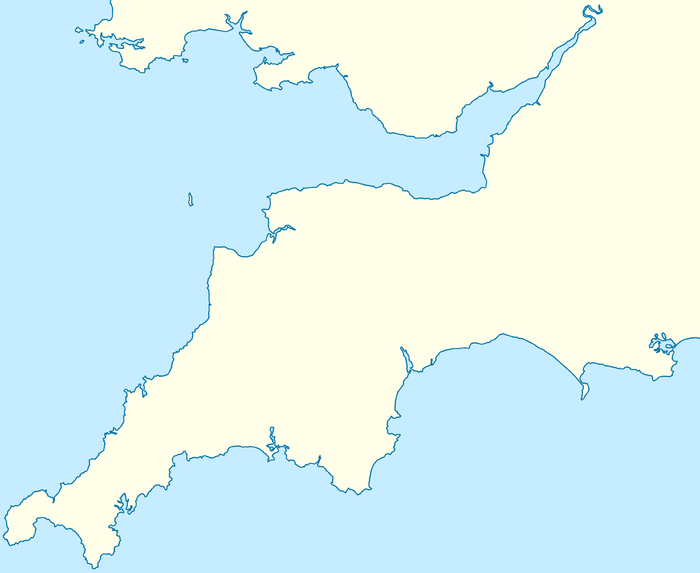Battle of Stratton
The Battle of Stratton, also known as the Battle of Stamford Hill,[2] took place on 16 May 1643, during the First English Civil War.
| Battle of Stratton | |||||||
|---|---|---|---|---|---|---|---|
| Part of the First English Civil War | |||||||
Site of the Battle of Stratton, c. 2010 | |||||||
| |||||||
| Belligerents | |||||||
|
|
| ||||||
| Commanders and leaders | |||||||
|
Sir Ralph Hopton Sir Bevil Grenville Sir Nicholas Slanning |
Earl of Stamford James Chudleigh | ||||||
| Strength | |||||||
|
2,400 foot 500 horse |
5,400 foot 200 horse 13 guns | ||||||
| Casualties and losses | |||||||
| Unknown |
300 dead 1,700 captured[1] | ||||||
The Royalists destroyed Parliament's field army in Devon and Cornwall, and followed up with a series of successes, including the capture of Exeter. The West Country remained under their control until 1646.
Background

When the war started, Cornwall was generally supportive of the Royalist cause, while Devon and Somerset were sympathetic to Parliament, though significant opposition existed in both areas.[3] In July 1642, Charles named the Marquess of Hertford his Lieutenant General in the West, with Sir Ralph Hopton as his deputy. The Earl of Stamford was given command of Parliament's army in the West Country in January 1643, and appointed James Chudleigh his deputy.[4]
At Sourton Down in April, Chudleigh captured letters ordering Hopton to join forces with Prince Maurice in Somerset. Seeing an opportunity for a decisive victory, Stamford raised the largest field army he could, stripping Parliamentary garrisons throughout Devon, and bringing reinforcements from Somerset.[5]
Most of his cavalry were sent on a diversionary raid against Bodmin, led by Sir George Chudleigh, father of James. Stamford marched on Stratton, and on 16 May, deployed his army half a mile to the north.[6]
Battle
Before dawn on 16 May, Hopton divided his army into four columns of 600 men and two cannons, keeping his horse in reserve. Hoping to surprise Stamford's army, these four columns advanced from four directions around 5:00 a.m. Hopton led the first column from the south, while Francis Bassett attacked from the north and Sir Bevil Grenville and Sir Nicholas Slanning attacked from the west.
The attack lost the element of surprise at the last moment, being discovered by a sentry who roused the Parliamentarian troops. Close action followed for the next eight hours, with determined effort on both sides. With the Royalist troops running short of ammunition, the Parliamentarian pikemen under Major-General James Chudleigh charged Grenville's regiment. Grenville was knocked over and his troops shaken, but Sir John Berkeley's musketeers made a counter-charge that stopped the Parliamentarian momentum and began to push their enemy back up the hill.
Against the odds the Royalist troops began to push forward, and around 3:30 p.m. the Royalist columns met at the top of the hill. On reaching the summit, Hopton released the Royalist cavalry as the Parliamentarians gave way. Stamford's defence crumbled under this pressure and his army fled the field. Three hundred Parliamentarian dead remained on the field, together with seventeen hundred prisoners.
Aftermath
James Chudleigh was taken prisoner. Accused of treason by Stamford, he promptly defected to the Royalists. The Earl of Stamford retreated to Barnstaple and then to Exeter, blaming the defeat on Chudleigh. George Chudleigh abandoned Bodmin, and returned to Exeter.
Citations
References
- Barratt, John (2005). The Civil War in the South-West. Barnsley: Pen & Sword Military. ISBN 1-84415-146-8.CS1 maint: ref=harv (link)
- "Battle of Stratton". Imperial War Museums. 2020. Retrieved 29 July 2019.
- "The Battle of Stratton". UK Battlefields Resource Centre. Retrieved 27 March 2020.
- Guest, Ken & Denise, British Battles (1997) ISBN 978-0-00-470968-0
- Hopper, Andrew J. (2020). Oxford Dictionary of National Biography. Oxford: Oxford University Press.